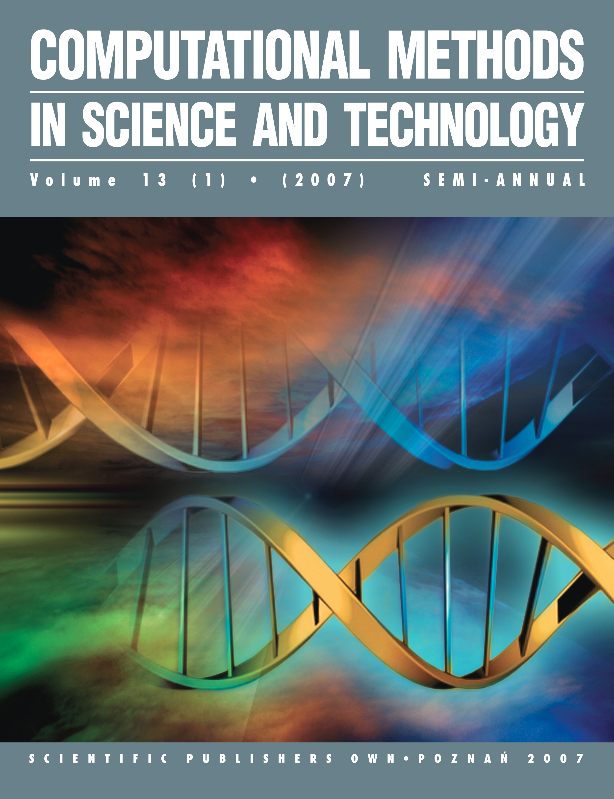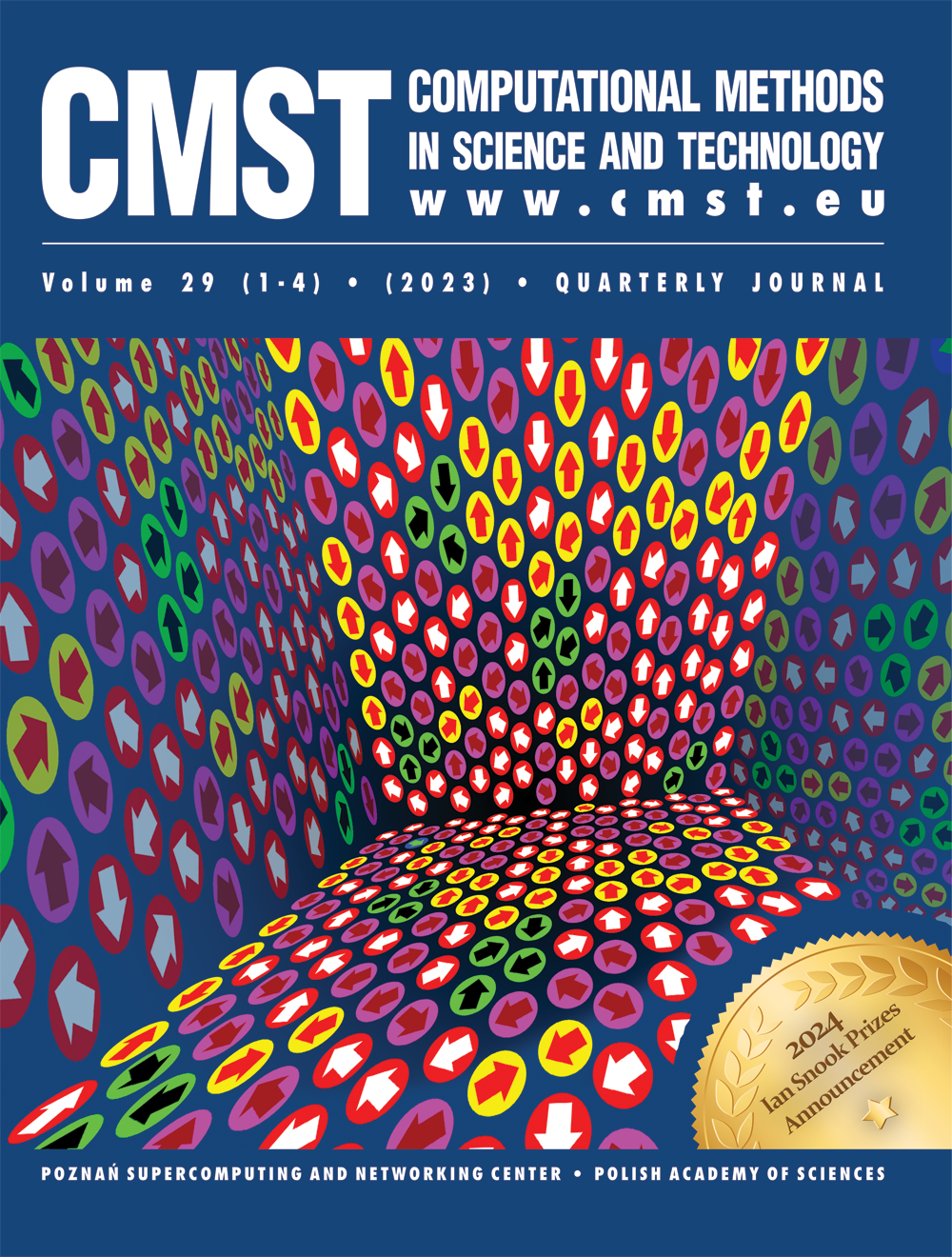INCREASING THE STABILITY OF LINEAR r12-CALCULATIONS ON THE MULTI-REFERENCE LEVEL OF THEORY*
Cardoen Wim 1, Gdanitz Robert J. 2
1 Henry Eyring Center for Theoretical Chemistry, Chemistry Dept., University of Utah,
Salt Lake City, UT 84112, U.S.A.
2Physics Dept., North Carolina State University,
Marteena Hall, Rm. 101, Greensboro, NC 27411, U.S.A.
Received:
Rec. 16 February 2004
DOI: 10.12921/cmst.2003.09.01.31-43
Abstract:
We investigate the performance of two approaches to remedy the notorious instability problems on explicitly correlated multi-reference averaged coupled-pair functional (r12-MR-ACPF) level of theory for the cases of HF molecule and Ne dimer. These two approaches are: i) the restriction of the unitary orbital invariance while retaining a chemically meaningful ansatz; ii) the contraction of associated r12-terms to geminals using amplitudes from the first-order perturbation theory wavefunction. We observe that our modifications outperform the extremal pair approach, which is commonly used on explicitly correlated coupled-cluster (CC-R12) level of theory and conclude that using geminals, which are e.g. taken from the first-order Møller-Plesset perturbation theory wavefunction instead, might be a better choice.
References:
[1] W. Kutzelnigg, Theoret. Chim. Acta 68, 445-469 (1985).
[2] W. Kutzelnigg and W. Klopper, J. Chem. Phys. 94, 1985-2001 (1991).
[3] R. J. Gdanitz, Chem. Phys. Lett. 210, 253-260 (1993).
[4] R. J. Gdanitz and R. Rohse, Intern. J. Quant. Chem. 55, 147-150 (1995); 59, E505 (1996).
[5] R. J. Gdanitz. In Recent Research Developments in Quantum Chemistry, vol. 3. Transworld Research Network, Kerala, India, 2002, pp. 245-276.
[6] W. Klopper, Chem. Phys. Lett. 186, 583-585 (1991).
[7] V. A. Fock, Izvest. Akad. Nauk S.S.S.R. Ser. Fiz. 18, 161-172 (1954); D. Kngl. Norske Videnskab. Selsk. Forh. 31, 138-152 (1958).
[8] T. Kato, Commun. Pure Appl. Math. 10, 151-177 (1957).
[9] I. Noga, W. Klopper and W. Kutzelnigg. In Recent advances in coupled cluster methods, R. J. Bartlett, Ed. World Scientific, Singapore, 1997, p. 1.
[10] W. Klopper. In Encyclopedia of Computational Chemistry, P. v. R. Schleyer, N. L. Allinger, T. Clark, J. Gasteiger, P. A. Kollman, H. F. Schaefer III, and P. R. Schreiner, Eds., vol. 4. John Wiley, Chichester, 1998, pp. 2351-2375.
[11] W. Klopper. In Modern methods and algorithms of quantum chemistry, J. Grotendorst, Ed., Vol. 1 of NIC series. John von Neumann Institute for Computing, Jiilich, 2000, pp. 153-201.
[12] W. Klopper and J. Noga. In Explicitly correlated wave functions in chemistry and physics; Theory and applications, J. Rychlewski, Ed., Kiuwer, 2003.
[13] C. Mo Her and M. S. Plesset, Phys. Rev. 46, 618-622 (1934).
[14] W. Klopper and W. Kutzelnigg, Chem. Phys. Lett. 134, 17-22 (1987).
[15] M. J. Bearpark, N. C. Handy, R. D. Amos and P. E. Maslen, Theoret. Chim. Acta 79, 361-372 (1991).
[16] J. Noga, W. Kutzelnigg and W. Klopper, Chem. Phys. Lett. 199, 497-504 (1992).
[17] J. “Noga and W. Kutzelnigg, J. Chem. Phys. 101, 1-25 (1994).
[18] R. J. Gdanitz, Chem. Phys. Lett. 283, 253-261 (1998); 288, E590-592 (1998); 295, E540 (1998).
[19] R. J. Gdanitz and R. Ahlrichs, Chem. Phys. Lett. 143. 413-420 (1988).
[20] R. J. Gdanitz, Intern. J. Quant. Chem. 85, 281-300 (2001).
[21] J. Noga and P. Valiron, Chem. Phys. Lett. 324, 166-174 (2000).
[22] J. Noga, P. Valiron and W. Klopper, J. Chem. Phys. 115, 2022-2032 (2001).
[23] R. J. Gdanitz. AMICA (“Atoms & Molecules In Chemical Accuracy”) suite of r12-MR-CI programs, unpublished, 1997. AMICA is distributed freely through the Internet site http://gdanitz.hec.utah.edu/amica.
[24] E. R. Davidson, .1. Comp. Phys. 17, 87-94 (1975).
[25] J. Noga and P. Valiron. In Computational chemistry: reviews of current trends, J. Leszczynski, Ed., vol. 7. World Scientific, 2002.
[26] P. Valiron, S. Kedzuch and J. Noga, Chem. Phys. Lett. 367, 723-729 (2003).
[27] W. Kutzelnigg and S. Vogtner, Intern. J. Quant. Chem. 60, 235-248 (1996).
[28] H. Müller, W. Kutzelnigg and J. Noga, Mol. Phys. 92, 535-546 (1997).
[29] W. Klopper, W. Kutzelnigg, H. Müller, J. Noga and S. Vogtner, Topics Curr. Chem. 203, 22-42 (1999).
[30] R. J. Gdanitz, Chem. Phys. Lett. 312, 578-584 (1999).
[31] P. S. Epstein. Phys. Rev. 28. 695-710 (1926).
[32] R. K. Nesbet, Proc. Roy. Soc. (London) A230, 312-321 (1955).
[33] COLUMBUS, an ab initio electronic structure program, release 5.4, 1998, written by H. Lischka, R. Shepard, I. Shavitt, F. B. Brown, R. M. Pitzer, R. Ahlrichs, H.-J. Böhm, A. H. H. Chang, D. C. Comeau, R. Gdanitz, H. Dachsei, C. Ehrhard, M. Ernzerhof, P. Hö.chtl, S. Irle, G. Kedziora, T. Kovar, Th. Müller, V. Parasuk, M. Pepper, P. Scharf, H. Schiffer, M. Schindler, M. Schüler, P. Szalay, M. Dallos, and J.-G. Zhao.
[34] R. Shepard, H. Lischka, P. G. Szalay, T. Kovar and M. Ernzerhof, J. Chem. Phys. 96, 2085-2098 (1992).
[35] S. F. Boys and F. Bernardi, Mol. Phys. 19, 553-566 (1970).
[36] H. Partridge, J. Chem. Phys. 90, 1043-1047 (1987).
[37] D. E. Woon, K. A. Peterson and T. H. Dunning, Jr. (unpublished).
[38] K. A. Peterson, D. E. Woon and T. H. Dunning, Jr., J. Chem. Phys. 100, 7410-7415 (1994).
[39] R. J. Gdanitz, Chem. Phys. Lett. 348, 67-74 (2001).
[40] V. Termath, W. Klopper and W. Kutzelnigg, J. Chem. Phys. 94, 2002-2019 (1991).
[41] J. A. Coxon and P. G. Hajigeorgiou, J. Mol. Spectrosc. 133, 45-60 (1989).
[42] W. T. Zemke, W. C. Stwalley, J. A. Coxon and P. G. Hajigeorgiou, Chem. Phys. Lett. 177, 412-418(1991).
[43] W. Cardoen and R. J. Gdanitz (in preparation).
[44] H. Primas. In Modern Quantum Chemistry, Part II: Interactions, O. Sinanoglu, Ed. Academic Press, New York, 1965, p. 45.
We investigate the performance of two approaches to remedy the notorious instability problems on explicitly correlated multi-reference averaged coupled-pair functional (r12-MR-ACPF) level of theory for the cases of HF molecule and Ne dimer. These two approaches are: i) the restriction of the unitary orbital invariance while retaining a chemically meaningful ansatz; ii) the contraction of associated r12-terms to geminals using amplitudes from the first-order perturbation theory wavefunction. We observe that our modifications outperform the extremal pair approach, which is commonly used on explicitly correlated coupled-cluster (CC-R12) level of theory and conclude that using geminals, which are e.g. taken from the first-order Møller-Plesset perturbation theory wavefunction instead, might be a better choice.
[1] W. Kutzelnigg, Theoret. Chim. Acta 68, 445-469 (1985).
[2] W. Kutzelnigg and W. Klopper, J. Chem. Phys. 94, 1985-2001 (1991).
[3] R. J. Gdanitz, Chem. Phys. Lett. 210, 253-260 (1993).
[4] R. J. Gdanitz and R. Rohse, Intern. J. Quant. Chem. 55, 147-150 (1995); 59, E505 (1996).
[5] R. J. Gdanitz. In Recent Research Developments in Quantum Chemistry, vol. 3. Transworld Research Network, Kerala, India, 2002, pp. 245-276.
[6] W. Klopper, Chem. Phys. Lett. 186, 583-585 (1991).
[7] V. A. Fock, Izvest. Akad. Nauk S.S.S.R. Ser. Fiz. 18, 161-172 (1954); D. Kngl. Norske Videnskab. Selsk. Forh. 31, 138-152 (1958).
[8] T. Kato, Commun. Pure Appl. Math. 10, 151-177 (1957).
[9] I. Noga, W. Klopper and W. Kutzelnigg. In Recent advances in coupled cluster methods, R. J. Bartlett, Ed. World Scientific, Singapore, 1997, p. 1.
[10] W. Klopper. In Encyclopedia of Computational Chemistry, P. v. R. Schleyer, N. L. Allinger, T. Clark, J. Gasteiger, P. A. Kollman, H. F. Schaefer III, and P. R. Schreiner, Eds., vol. 4. John Wiley, Chichester, 1998, pp. 2351-2375.
[11] W. Klopper. In Modern methods and algorithms of quantum chemistry, J. Grotendorst, Ed., Vol. 1 of NIC series. John von Neumann Institute for Computing, Jiilich, 2000, pp. 153-201.
[12] W. Klopper and J. Noga. In Explicitly correlated wave functions in chemistry and physics; Theory and applications, J. Rychlewski, Ed., Kiuwer, 2003.
[13] C. Mo Her and M. S. Plesset, Phys. Rev. 46, 618-622 (1934).
[14] W. Klopper and W. Kutzelnigg, Chem. Phys. Lett. 134, 17-22 (1987).
[15] M. J. Bearpark, N. C. Handy, R. D. Amos and P. E. Maslen, Theoret. Chim. Acta 79, 361-372 (1991).
[16] J. Noga, W. Kutzelnigg and W. Klopper, Chem. Phys. Lett. 199, 497-504 (1992).
[17] J. “Noga and W. Kutzelnigg, J. Chem. Phys. 101, 1-25 (1994).
[18] R. J. Gdanitz, Chem. Phys. Lett. 283, 253-261 (1998); 288, E590-592 (1998); 295, E540 (1998).
[19] R. J. Gdanitz and R. Ahlrichs, Chem. Phys. Lett. 143. 413-420 (1988).
[20] R. J. Gdanitz, Intern. J. Quant. Chem. 85, 281-300 (2001).
[21] J. Noga and P. Valiron, Chem. Phys. Lett. 324, 166-174 (2000).
[22] J. Noga, P. Valiron and W. Klopper, J. Chem. Phys. 115, 2022-2032 (2001).
[23] R. J. Gdanitz. AMICA (“Atoms & Molecules In Chemical Accuracy”) suite of r12-MR-CI programs, unpublished, 1997. AMICA is distributed freely through the Internet site http://gdanitz.hec.utah.edu/amica.
[24] E. R. Davidson, .1. Comp. Phys. 17, 87-94 (1975).
[25] J. Noga and P. Valiron. In Computational chemistry: reviews of current trends, J. Leszczynski, Ed., vol. 7. World Scientific, 2002.
[26] P. Valiron, S. Kedzuch and J. Noga, Chem. Phys. Lett. 367, 723-729 (2003).
[27] W. Kutzelnigg and S. Vogtner, Intern. J. Quant. Chem. 60, 235-248 (1996).
[28] H. Müller, W. Kutzelnigg and J. Noga, Mol. Phys. 92, 535-546 (1997).
[29] W. Klopper, W. Kutzelnigg, H. Müller, J. Noga and S. Vogtner, Topics Curr. Chem. 203, 22-42 (1999).
[30] R. J. Gdanitz, Chem. Phys. Lett. 312, 578-584 (1999).
[31] P. S. Epstein. Phys. Rev. 28. 695-710 (1926).
[32] R. K. Nesbet, Proc. Roy. Soc. (London) A230, 312-321 (1955).
[33] COLUMBUS, an ab initio electronic structure program, release 5.4, 1998, written by H. Lischka, R. Shepard, I. Shavitt, F. B. Brown, R. M. Pitzer, R. Ahlrichs, H.-J. Böhm, A. H. H. Chang, D. C. Comeau, R. Gdanitz, H. Dachsei, C. Ehrhard, M. Ernzerhof, P. Hö.chtl, S. Irle, G. Kedziora, T. Kovar, Th. Müller, V. Parasuk, M. Pepper, P. Scharf, H. Schiffer, M. Schindler, M. Schüler, P. Szalay, M. Dallos, and J.-G. Zhao.
[34] R. Shepard, H. Lischka, P. G. Szalay, T. Kovar and M. Ernzerhof, J. Chem. Phys. 96, 2085-2098 (1992).
[35] S. F. Boys and F. Bernardi, Mol. Phys. 19, 553-566 (1970).
[36] H. Partridge, J. Chem. Phys. 90, 1043-1047 (1987).
[37] D. E. Woon, K. A. Peterson and T. H. Dunning, Jr. (unpublished).
[38] K. A. Peterson, D. E. Woon and T. H. Dunning, Jr., J. Chem. Phys. 100, 7410-7415 (1994).
[39] R. J. Gdanitz, Chem. Phys. Lett. 348, 67-74 (2001).
[40] V. Termath, W. Klopper and W. Kutzelnigg, J. Chem. Phys. 94, 2002-2019 (1991).
[41] J. A. Coxon and P. G. Hajigeorgiou, J. Mol. Spectrosc. 133, 45-60 (1989).
[42] W. T. Zemke, W. C. Stwalley, J. A. Coxon and P. G. Hajigeorgiou, Chem. Phys. Lett. 177, 412-418(1991).
[43] W. Cardoen and R. J. Gdanitz (in preparation).
[44] H. Primas. In Modern Quantum Chemistry, Part II: Interactions, O. Sinanoglu, Ed. Academic Press, New York, 1965, p. 45.



